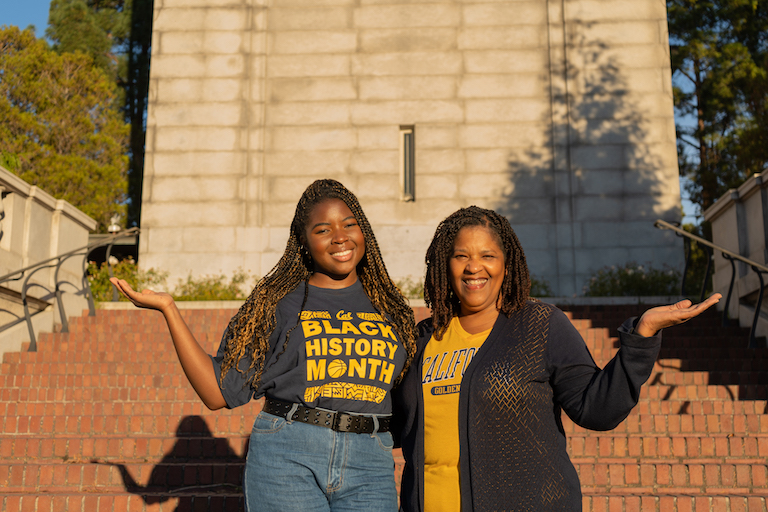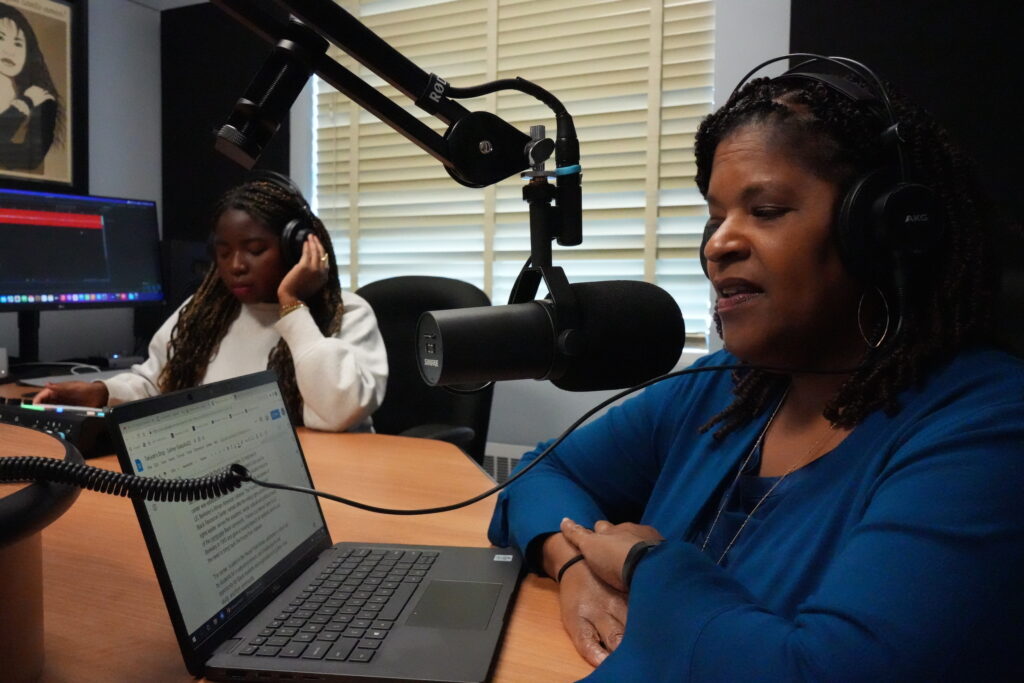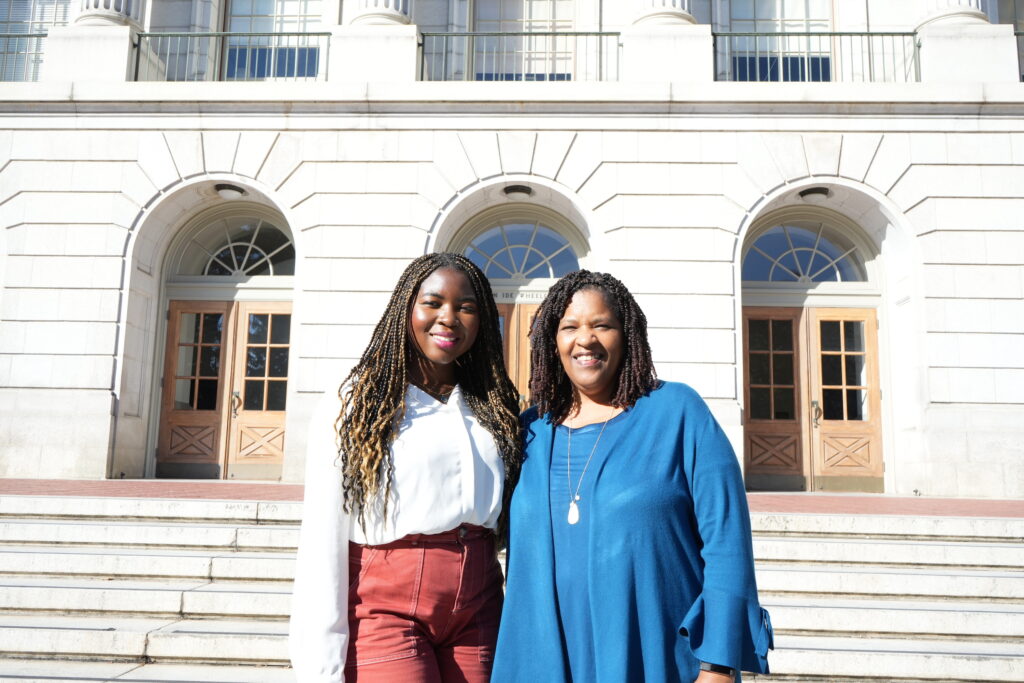
Celebrating Black History Year-Round
Last year I was able to speak with Gia White and Daniella Lake, members of Black Lives at Cal (BLAC), about a project they were working on: a self-guided audio tour of Black history on the UC Berkeley campus. Recently, I had the opportunity to join a campus tour guided by Gia and Daniella. This experience not only deepened my understanding of the campus’s overall history but also provided me with significant insights into the realm of its Black historical context. Read on to discover what went into this tour, and to learn about Black history on campus.
Creating the tour
You mentioned on the guided walking tour that there is a lot more history than what was included—how did you decide what to include?
Gia: This was all originally a walking tour. I decided on the stops, and then I met with Daniella, we did a pilot walking tour, and we moved on to create the audio tour. Originally, the tour was going to be focused on the first African American students to attend Berkeley, so I was selecting buildings to feature based on that. I also started to think about the first Black faculty, Black student collective action, and the physical locations tied to these and other events. The tour evolved from thinking about individuals to events, and national leaders coming to campus. We also wanted to feature some of the iconic spots on campus, which are also tied to Black history, to round out the tour.
Daniella: The tour has a lot of different stories, which shows how Black life at Berkeley isn’t a monolith. It’s well-rounded because it includes different examples of Black life on campus, from notable figures like Black leaders visiting campus to the first set of Black students and the first Black professors. We also mention places like the Black Wednesday wall, a space where the Black community gathers.
How many people and campus departments went into the creation of this tour?
Gia: Black Lives at Cal came into being through Dr. Takiyah Jackson. From that came my role on the steering committee, seeking me out because of an article I wrote on the first African American woman who attended Berkeley. We had a new platform and it all started to come together. We hired Caleb Dawson who now runs BLAC, and we hired URAPS, Daniella being in the first cohort. The Black Studies Collaboratory was a funding opportunity that benefitted the project, allowing us to fund stipends for our student workers.
Daniella: The Changemaker Podcast Studio, which is under the Ethnic Studies Department and led by Professor Pablo Gonzalez, was a great help in the creation of the tour. It was created to be a place where people on campus could come and tell the stories of marginalized communities. It was also really special getting to work with Gia, who was a student on campus before joining as a staff member. From BLAC I also got to meet other Black students and make Black friends, which was important for me because growing up I didn’t have a Black community. It all feels like a jackpot experience because I got to learn about Black history on campus and be inspired by it, share it with others, all the while expanding my professional skills.

Daniella (left) and Gia (right) recording at the Changemaker Podcast Studio. Photo by Jacqlyn Jones.
Viewing campus in a new light
Towards the end of the tour at Wheeler Hall, I discovered an interesting fact: W.E.B. Du Bois, renowned Black sociologist, author, and activist frequently discussed in my English classes, once visited our campus. In 1923, W.E.B. Debois gave a speech at Wheeler Hall, in turn inspiring Louise Alone Thompson Patterson, one of the first African American women to graduate from UC Berkeley. He’s frequently mentioned in my classes that take place in Wheeler, and none of my professors have ever mentioned it, even as a fun fact. I think a lot of people don’t know or realize how many interesting and influential people have visited campus, who continue to have a lasting legacy and impact even decades later.
How did creating the tour change the way you view the UC Berkeley campus?
Gia: When I hear the Campanile bells, I remember how many people came before me and heard the same song. The people who came before, we are an extension of their legacy. More people have to hear their stories—they’re an inspiration for students like Daniella, who might think there are not that many Black people at Berkeley, who might feel isolated. Learning and highlighting all of these stories and this history is a way to tell them that we’ve been here, even before the Campanile itself, and you belong. Working with students like Daniella just fills me up so much. They’re so young and eager, they appreciate the generational exchanges that we have. The intergenerational aspects that continue to happen make the project so rich.
Daniella: I feel so lucky to have been a part of BLAC, and to have been part of creating this project. Because I’ve gotten to learn so much about the campus’s Black history through creating the tour. It therefore has greatly impacted the way I see campus, and I know it’s not the same way everyone else sees campus. Walking by Memorial Stadium I now think about Walter Gordon. I think about how he was the first All-American football player, an icon who did so many amazing things in his life. Right next to the stadium is International House, and I think about Delilah Beaseley, a Black woman who was at the forefront of advocating for the creation of I-House. Walking by Berkeley Law, I think about how the first Black female lawyer in California went to Berkeley Law. It gives me a sense of pride, knowing that we did that. Even though I never met these people, and I’ve only heard their stories, I feel so connected to them. When I walk around campus, I think about them, I think about the things they achieved, and there’s just something really special about knowing I’m standing on the same ground as them, and that they came before me and it almost feels like a spiritual experience. I also learned that Black students have been attending UC Berkeley since before the Campanile was built and that knowledge has added to my sense of belonging.

Daniella and Gia in front of Wheeler Hall. Photo by Jacqlyn Jones.
The tour’s impact
On the tour, we also learned about some buildings in and around campus named after influential Black people who attended UC Berkeley, including the Ida Louise Jackson Graduate House and the Barbara Christian Hall in Unit 1. These buildings have images of their namesakes inside, but are uncaptioned, providing little context to the students who live within them.
How is the tour inspiring change in the campus community?
Gia: The people who go on the tours we host are often Berkeley staff members. On the first few tours, I mentioned how the Ida Louise Jackson Graduate House and Barbara Christian Hall don’t sufficiently showcase the importance of these women. Someone in the audience worked in the housing department at the university, and they offered to help. They emailed their directors, I put together a proposal, and that’s currently in the works. In another tour, I mentioned the lack of good evidence that Walter Gordon was the first All-American from Cal. Someone who knew the Cal athletic director was on that tour, and later cc’ed me on an email to the director explaining what they had learned on the tour and asking what action could be taken, asking why Walter Gordon wasn’t more celebrated. People act on what they learn and what they feel after the tour, and this impact leads to change. It’s pretty incredible to witness.
Daniella: We’re often told, especially when talking about racial justice and diversity, that progress is slow, and we have to be patient. To see some of these quick changes, like seeing the unveiling of the statue of Professor Joseph Gier, and getting to witness these things in real-time, while I’m still a student here is really special.
What’s next for BLAC
What are some upcoming projects or events that the campus community can get involved in?
Gia: BLAC is hosting The Upload Event, where we are asking people in the community to bring their memorabilia related to being a student at Cal. We’re gathering that data and archiving the history of alumni and other campus community members in that way. To learn about the Upload Event and more Black History events, check out the Division of Equity & Inclusion’s page on Celebrating Black History Month.
At the last stop on the tour, Sproul Plaza / MLK Student Union, one of the attendees shared that she was on Sproul on May 17, 1967, when Martin Luther King Jr. gave his speech to a crowd of over 7,000 students. A lot of this history was not as long ago as we may think, and it continues to have a lasting impact on all of our lives. I hope this inspired you to go on the Self-Guided Audio tour to learn about all of these things and more, and to view campus in a new way.
Melissa Mora-Gonzalez is a third-year at UC Berkeley majoring in English and minoring in conservation and resource studies.
Want More?
- Read more about BLAC and its impact
- Discover all the Black Resource Center has to offer
- Learn about Daniella’s internship at the Smithsonian